- Blog
- AI A/B Testing: How to Optimize Your Website Effectively & Make Data-Driven Decisions
AI A/B Testing: How to Optimize Your Website Effectively & Make Data-Driven Decisions
-
Barbara Bartucz
- Conversion
- 6 min read
Table of Contents
As an ecommerce store owner, you’re juggling inventory, marketing, customer service, and on top of it all, trying to optimize your website for better conversions… if you have the time for it, that is.
Traditional A/B testing can feel like a time-consuming puzzle—waiting for results, interpreting data, and often second-guessing the insights.
Luckily, there’s a faster, smarter way to test and optimize your site: AI A/B testing, your new secret weapon for making data-driven decisions effortlessly.
In this article, we’ll cover everything you need to know about AI-driven A/B testing: its advantages, how to implement it, and some common pitfalls.
Ready to dive in?
Basics of A/B testing
A/B testing, also known as split testing, involves comparing two versions of a webpage to see which one performs better.
By showing different versions to users at random, you can measure which variation drives more conversions, clicks, or other key metrics.
Why is this important? Because A/B testing lets you move beyond guesswork to make decisions based on real data.
It’s all about optimizing the user experience, increasing engagement, and boosting your bottom line.
Here are the key components of A/B testing:
- Control: The original version of your webpage.
- Variant: The modified version you want to test against the control.
- Metrics: The criteria you use to judge performance, such as conversion rates, click-through rates, or time on page.
What are the common challenges in traditional A/B testing?
Traditional A/B testing has lots of hurdles—it’s no wonder most marketers don’t embrace it. Let’s break them down, one by one.
1. It’s time consuming
Traditional A/B testing can be slow. You create your variants, but then gathering data to reach statistical significance can be slow, especially if your website has low traffic. This process can take weeks or months, delaying decisions and hampering agility in a competitive market.
2. It requires significant resources
Running A/B tests demands significant time and manpower. Designing variants, implementing changes, monitoring performance, and analyzing outcomes require dedicated resources. This can strain smaller teams and divert attention from other critical tasks.
3. You need expertise
Effective A/B testing requires expertise. Without it, businesses can struggle with setup and analysis, leading to biased results and misguided conclusions. This lack of knowledge can waste time and resources, making A/B testing seem like more trouble than it’s worth.
4. It’s difficult to analyze complex data sets
Interpreting A/B test data is tricky. Complex data sets require advanced analysis techniques beyond basic statistics. Misunderstanding metrics like confidence intervals and p-values can lead to incorrect decisions, hindering your optimization efforts.
The role of AI in A/B testing
AI and machine learning use algorithms that learn from data and make predictions.
Unlike traditional methods, artificial intelligence adapts and improves over time, making it a powerful tool for A/B testing.
Generative AI can assist in optimizing A/B testing strategies by creating hyper-personalized user experiences and predicting user behavior based on historical data.
Natural language processing plays a crucial role in the development and functionality of these generative AI models, enabling them to generate coherent text by analyzing word usage and meaning.
Traditional A/B testing relies on static methods and human analysis. In contrast, AI-driven A/B testing uses dynamic algorithms to continuously learn and optimize, offering more accurate and actionable insights.
This means faster results, the ability to precisely locate your target audience, and the capacity to handle complex data sets effortlessly.
In a nutshell, AI takes the guesswork out of optimization.
What are the advantages of AI in A/B testing?
So how can AI help you tackle all the challenges we mentioned previously? Let’s break it down!
1. It’s fast and efficient
AI can analyze data faster than any human, significantly reducing the time required to get results from your A/B tests.
AI-powered platforms can test multiple variables simultaneously, improving the speed and accuracy of marketing experiments while allowing for a deeper analysis of complex data patterns.
2. It can easily handle large and historical data sets
AI excels at processing large volumes of data. Using historical data, AI can improve A/B testing processes by predicting user behavior and enhancing experimentation outcomes.
AI’s ability to manage and interpret vast data sets ensures you get comprehensive insights without the usual time and resource constraints.
3. It empowers you to make data-driven decisions
AI-driven A/B testing provides more accurate predictions and deeper insights. By continuously learning from the data, AI helps you make better decisions—decisions backed up by real data.
This precision eliminates guesswork and enhances your ability to implement effective strategies.
How to implement AI-driven A/B testing?
Choosing the right AI tool can both streamline your A/B testing process and ensure data compliance, using AI-powered functionalities to effectively analyze test results and optimize your marketing strategies.
One standout tool for AI-driven A/B testing is OptiMonk’s Smart A/B Testing tool.
It’s a fully automated AI-powered solution that identifies the best-performing text elements on your landing pages.
One crucial aspect of AI-driven A/B testing is formulating and testing hypotheses, and this tool excels in that arena.
By generating and refining test hypotheses within the context of data analysis and experimentation, AI automates the process of creating and prioritizing these hypotheses based on their potential impact.
This ensures more efficient allocation of testing resources and increases the likelihood of successful outcomes.
Here’s how it works: The AI tool automatically cycles through your text variants, comparing each one against the top performer until the best option is identified. This saves you time by handling all the setup and decision-making for you.
OptiMonk’s Smart A/B Tests can optimize various text elements on your landing pages, including:
- Headlines
- Subheadlines
- CTA button texts
- Product descriptions
Here’s how to set up a Smart A/B Test with OptiMonk:
Step 1. Start a new campaign and add your domain:
Select or add the domain where you’d like to run your Smart A/B Test.
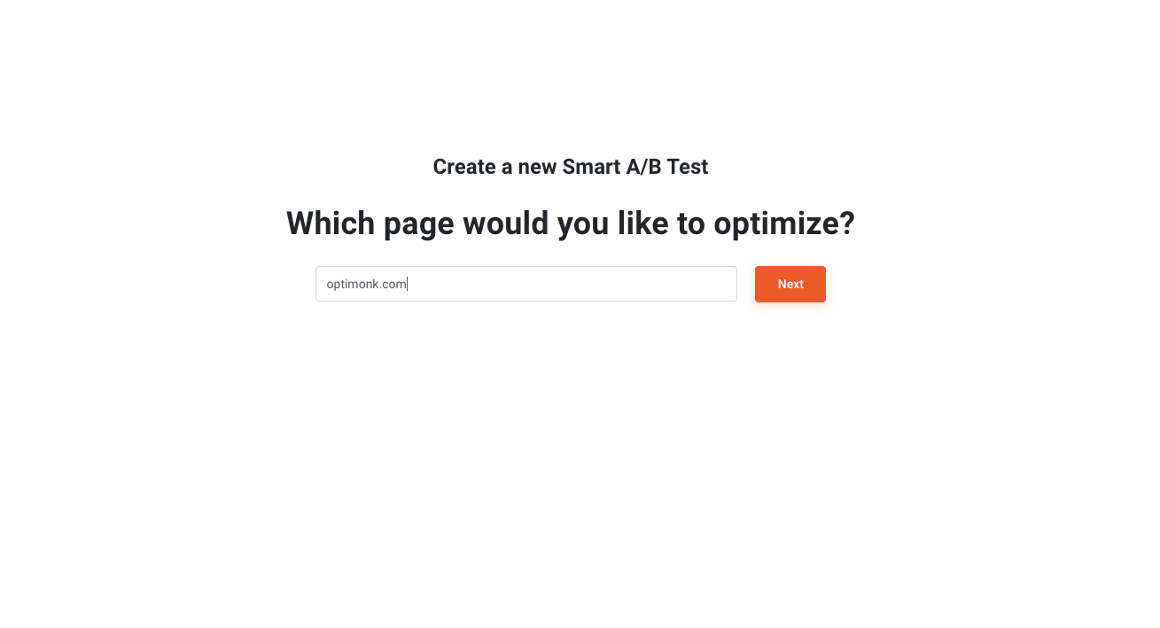
Step 2. Get recommendations or create your own test:
OptiMonk can suggest landing page elements for optimization. Click “Get Recommendations” or create your own A/B test.
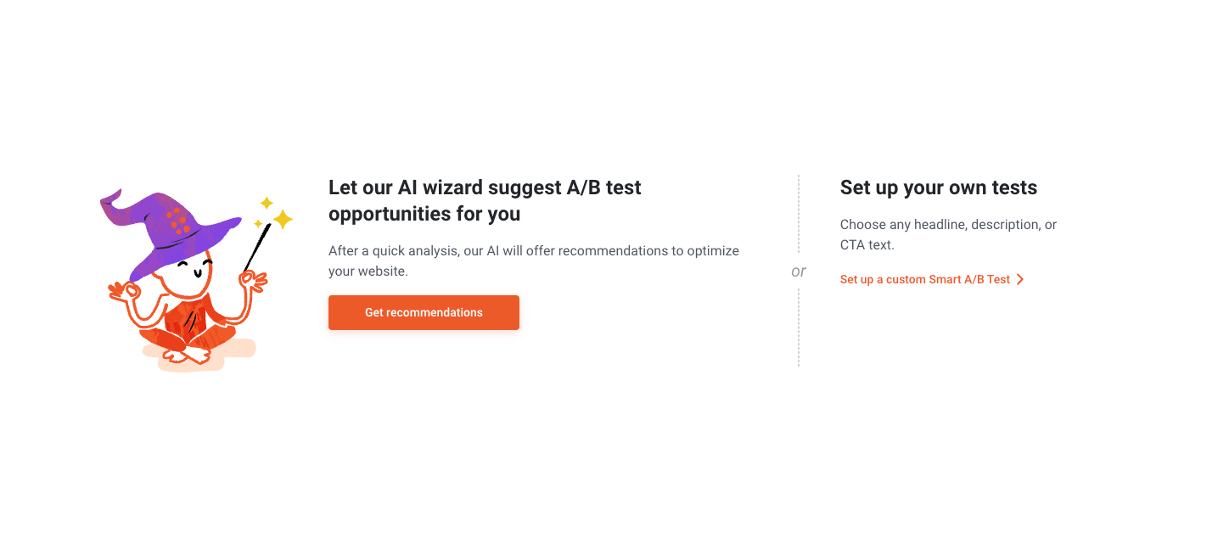
Step 3. Launch the Dynamic Content Editor:
OptiMonk will launch your website within its Dynamic Content Editor. Navigate to the specific page you wish to test using “Navigation” mode.
Switch to “Edit” mode to begin making changes. Click on the element (e.g., headline) you’d like to test.
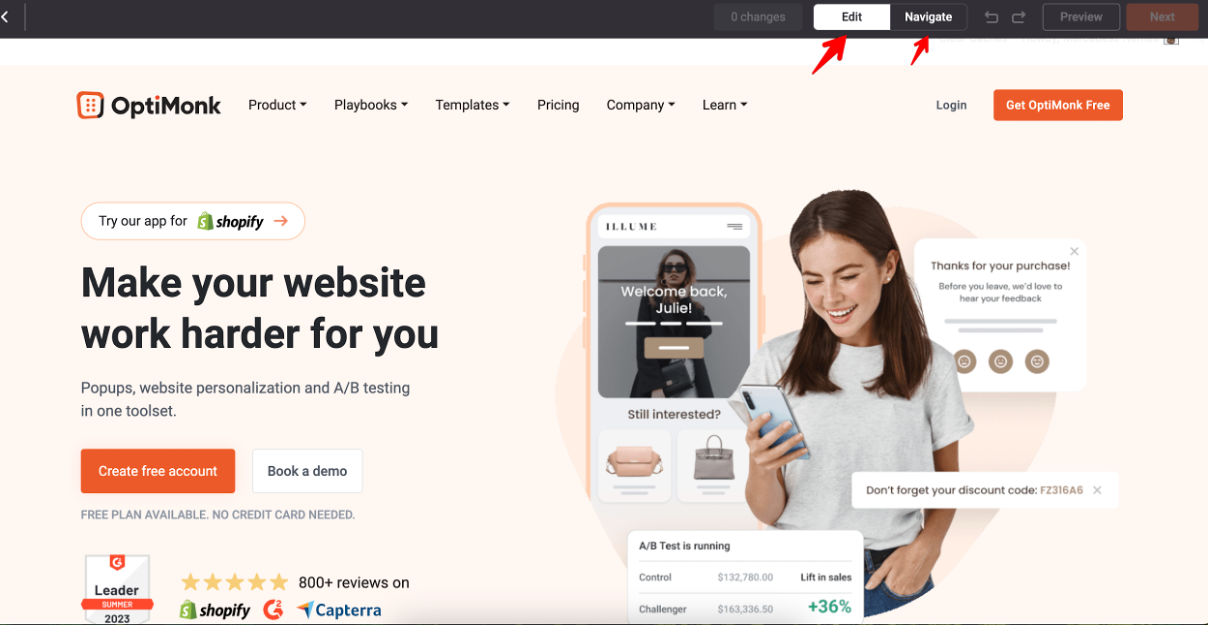
Step 4. Generate alternative headlines:
OptiMonk will automatically generate alternative headlines for you to test against your original headline. You can modify or delete these as needed.
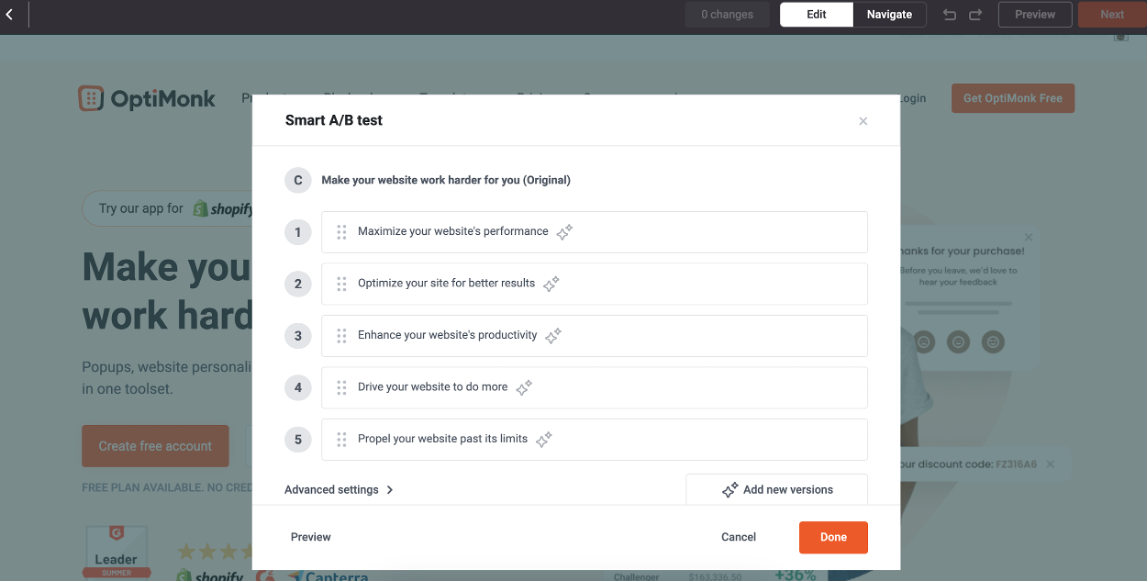
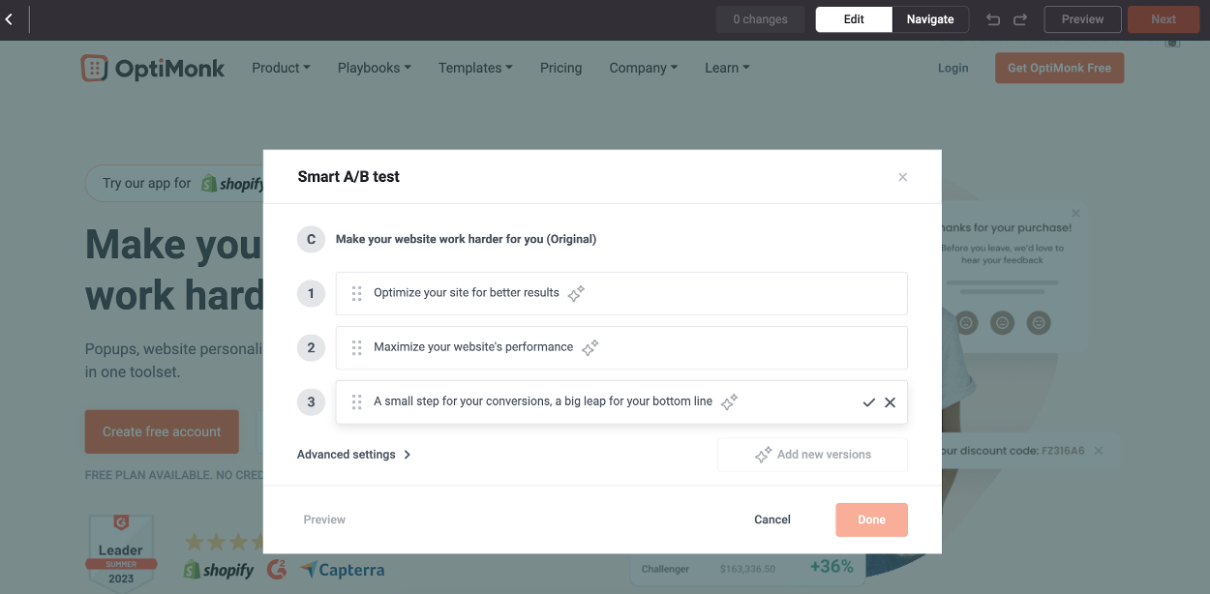
Step 5. Preview your variants:
Click on “Preview” to see how your page appears with different headline variants. Share the URL of the preview with your teammates or open the preview to see each variant.
Use the arrow in “Preview” mode to cycle through and view each headline variant.
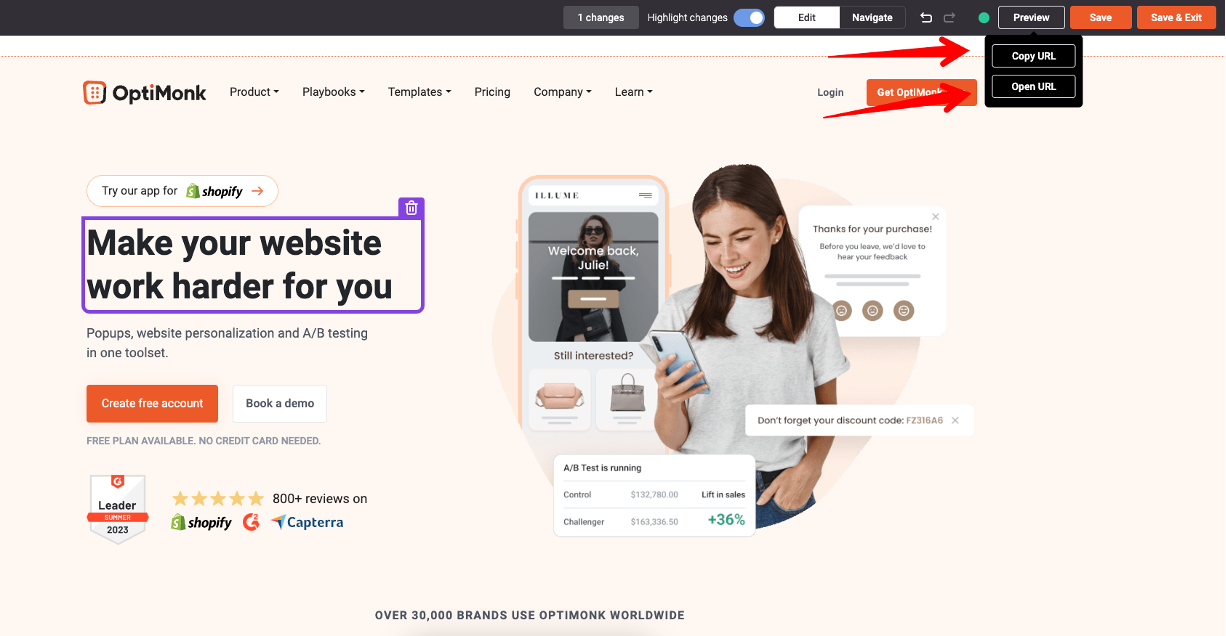
Step 6. Save your variants:
After adding your variants and clicking “Save,” specify the pages where your A/B test should run. For example, if you’re testing on your homepage, set the URL rule accordingly.
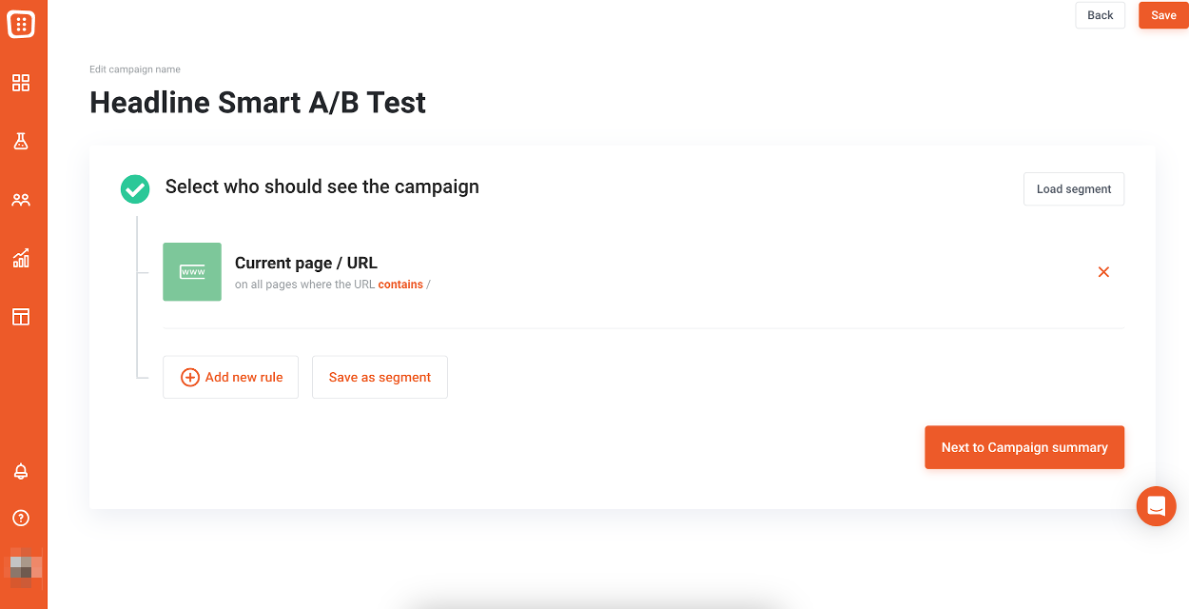
For a more detailed guide, check out our support article.
Common pitfalls to avoid in AI A/B Testing
AI-driven A/B testing can significantly enhance your optimization efforts, but it’s not without its challenges. Understanding and avoiding common pitfalls can help you leverage AI to its fullest potential.
Here are some key mistakes and misconceptions to watch out for, plus tips on how to avoid them.
1. Over-reliance on AI
One of the biggest misconceptions is that AI can do everything. While AI can automate and optimize many aspects of A/B testing, it’s not a replacement for human oversight. Relying solely on AI without understanding the underlying data and logic can lead to misinformed decisions.
Always combine AI insights with your industry knowledge and intuition.
2. Ignoring data quality
AI is only as good as the data it processes. Poor data quality can lead to inaccurate results and flawed conclusions. Ensure that your data is clean, relevant, and comprehensive.
Regularly audit your data sources and validate the data to maintain high quality.
3. Setting unrealistic expectations
Expecting immediate, groundbreaking results from AI-driven A/B testing can lead to disappointment. AI can significantly speed up the testing process and provide deeper insights, but it still requires time to learn and optimize.
Set realistic expectations and be patient as the AI refines its algorithms.
4. Misinterpreting results
AI can analyze complex data sets and provide detailed insights, but interpreting these results correctly is crucial. Misunderstanding metrics, such as statistical significance or confidence intervals, can lead to incorrect conclusions.
Ensure you or your team has a solid understanding of statistical principles and AI output to make informed decisions.
5. Neglecting continuous learning
AI thrives on continuous learning and improvement. However, some businesses set up AI-driven A/B tests and then neglect to update or review them regularly. AI models need constant feeding of new data and periodic adjustments to stay relevant and accurate.
Make continuous learning a core part of your AI strategy.
FAQ
What is artificial intelligence?
Artificial intelligence (AI) simulates human intelligence in machines. These systems can process data, recognize patterns, make decisions, and learn over time, making them useful for tasks like A/B testing.
How do I choose the right AI-driven A/B testing tool?
Choosing the right AI-driven A/B testing tool involves considering several key features:
- Automation: The tool should automate as many aspects of the A/B testing process as possible, from setting up tests to analyzing results, to save you time and effort.
- Ease of use: Look for a user-friendly interface that doesn’t require advanced technical skills. This ensures that your team can easily adopt and use the tool effectively.
- Robust analytics: The tool should offer comprehensive analytics capabilities, providing deep insights into test performance and user behavior.
- Scalability: Ensure the tool can handle the volume of data and traffic your website generates and can scale as your business grows.
- Integration: Check if the tool integrates seamlessly with your existing systems, such as your CMS, CRM, and other marketing tools.
- Positive user reviews: Look for testimonials and reviews from other users to gauge the tool’s reliability, effectiveness, and the quality of its customer support.
Future trends in AI-powered experimentation, particularly in A/B testing, are reshaping testing strategies and predicting consumer behavior. This helps marketers make informed decisions and improves their marketing efforts.
What is OptiMonk’s Smart A/B Testing tool?
OptiMonk’s Smart A/B Testing tool uses artificial intelligence to automate A/B testing.
It creates and tests variants, learns from data, and provides detailed insights, optimizing elements like headlines, CTAs, and product descriptions for better performance.
By analyzing test results, you gain a clear understanding of the statistical significance of your data and its impact on key performance indicators (KPIs). This process is crucial for making informed decisions and effectively engaging with your target audience.
Wrapping up
Embracing AI-driven A/B testing can significantly enhance your website optimization efforts.
By using tools like OptiMonk’s Smart A/B Testing, you can save time, make better decisions, and ultimately boost your site’s performance.
Ready to take your website optimization strategy to the next level? Give AI-driven A/B testing a try and watch your conversions soar!
Migration has never been easier
We made switching a no-brainer with our free, white-glove onboarding service so you can get started in the blink of an eye.

What should you do next?
Thanks for reading till the end. Here are 4 ways we can help you grow your business:
Boost conversions with proven use cases
Explore our Use Case Library, filled with actionable personalization examples and step-by-step guides to unlock your website's full potential. Check out Use Case Library
Create a free OptiMonk account
Create a free OptiMonk account and easily get started with popups and conversion rate optimization. Get OptiMonk free
Get advice from a CRO expert
Schedule a personalized discovery call with one of our experts to explore how OptiMonk can help you grow your business. Book a demo
Join our weekly newsletter
Real CRO insights & marketing tips. No fluff. Straight to your inbox. Subscribe now
Barbara Bartucz
- Posted in
- Conversion

Partner with us
- © OptiMonk. All rights reserved!
- Terms of Use
- Privacy Policy
- Cookie Policy
Product updates: January Release 2025








